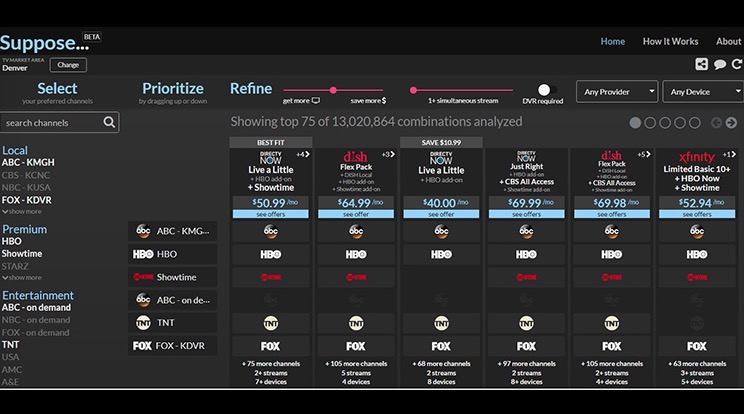New Startup Helps Consumers Comparison Shop for Pay TV

Related: Slinging Away From the Pack
With the rise of virtual over-the-top providers such as YouTube TV and Sling TV alongside traditional pay TV providers, consumers have never had more choice amid these ever-expanding options.
Of course, those offerings are far from uniform, and not every service or package is created equal. While some consumers still want a full-freight pay TV offering, others have been gravitating to skinnier, less expensive bundles. Some package deals require long-term contracts; others don’t.
While this gives consumers plenty to choose from, not every consumer is the same when it comes to which channels they prefer, making it a significant challenge to figure out which package or service best suits their needs due to the ongoing lack of a true a la carte model.
Enter Suppose, a privately held startup company that takes aim at this challenge/opportunity. It recently launched a free service (at suppose.tv) that helps consumers comparison-shop, based on the channels they like the most, between legacy providers such as Comcast and DirecTV along with relative newcomers such as Hulu Live, fuboTV, YouTube TV and PlayStation Vue, and specialized standalone subscription services that include CBS All Access and HBO Now.
Boiled down, Suppose hopes to do for pay TV what Kayak does for travel — collect and aggregate data from a wide range of sources and providers to help consumers find the best deals that suit their needs.
Sifting For What Works Best
Broadcasting & Cable Newsletter
The smarter way to stay on top of broadcasting and cable industry. Sign up below
“We recognized that the pay TV [universe] is extremely complicated,” Andrew Shapiro, a co-founder of Suppose, said. “With every new service, what used to be a very simple decision has become increasingly complicated.”
“New providers tend to be cheaper and offer smaller packages, but that might not be suitable for everyone,” as support for local network affiliates tends to be spotty among the OTT players, added John Tantum, another co-founder and a former president of Virgin Mobile USA.
Consumers could compare and contrast those services by creating their own spreadsheets, of course, but it’s a tedious, cumbersome approach, meaning the “time is ripe” for a company like Suppose to step in and do that analysis, he said.
Suppose is starting off as a channel-oriented tool that can compare what’s offered by each pay TV provider, including cable operators in the top 30 markets, and present results based on which networks consumers want the most. Further out, Suppose expects to factor in data from subscription services such as Netflix and Amazon Prime.
As for its approach, Suppose users initially confirm or select their market, pick and prioritize the TV channels they watch, and give an idea of their price sensitivity. From there, Suppose’s algorithm filters and ranks the service options, and presents what it views as the best option that would satisfy those choices at the lowest possible cost.
Users can refine results using sliders that determine results by price sensitivity, number of streams supported and whether or not the consumer requires their service to support a DVR.
Suppose is a free service that will remain unbiased, but it’s exploring a business model in which it would collect affiliate fees from service providers.
Tantum said Suppose is in talks with several providers that are interested in working with the company to deliver promotions to consumers who use the system.
The Corte Madera, Calif.-based company, founded earlier this year, is just one startup that has spotted a need to help consumers cut through the video clutter. Another among them is CobbleCord, a startup founded by former Showtime Networks executive Virginia Juliano that helps users create a “metabundle” using a database packed with pricing and packaging from more than 100 OTT services.










